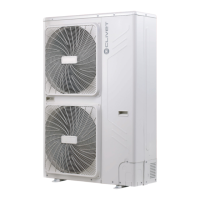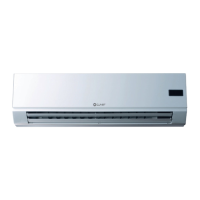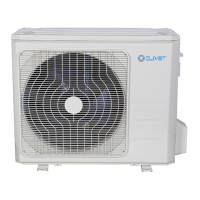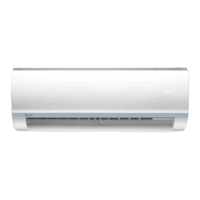50
Start-up
8 STARTUP
8.1 Start-up preparations
After installation and configuration of the settings, the
personnel must check that these have been carried out
correctly. Therefore, the steps below must be followed to
perform the test run.
The test can be carried out once installation is complete.
The test generally involves the following steps:
– Read the “Checklist before execution of the test”.
– Carry out the operating test.
– Correct any errors before the test can end with
exceptions.
– Run the system
l
WARNING
During the test, the outdoor unit runs at the
same time as the indoor units connected to it.
It is very dangerous to perform debugging of
the indoor unit during the test.
Do not remove the cover of the fan. The fan
can cause physical injury when running at high
speed.
a
CAUTION
Make sure that the insulation to earth is at
least 1 M Ω
l
WARNING
Make sure that power is supplied to the unit
at least 12 hours before starting it so that the
casing heater can run eectively to protect the
compressor.
l
WARNING
The test can be carried out when the room
temperature is between -20 °C and 35 °C.
l
WARNING
The operating test can only be carried out
when all the valves are open.
a
CAUTION
Never force switch-on. (Disabling the
protection device can lead to dangerous
situations.)
During the tests, the outdoor unit and the indoor one
start at the same time. Make sure that all the preparations
for the indoor unit have been completed. Refer to the
installation manual of the indoor unit for the pertinent
information
8.1.1 Checklist before running the test
After installing the unit, first check the following points.
After carrying out all the checks below, turn o the unit.
This is the only way to restart the unit.
Carry out the following checks:
Check mechanical assembly of the outdoor unit.
See “3 Installation” page 14
Check that the electrical wiring has been done
correctly.
See “5 Electrical connections” page 31
Check that the refrigerant piping has been
installed correctly.
See “4 Refrigerant piping” page 19
Checking the power supply voltage
The voltage must be the same as the one indicated
on the identification plate
Checking the earth line
Make sure that the earth line is connected properly
and that the earth terminal is watertight
Insulation test of the main circuit
Use the DC500 of 500V, apply a voltage of 500V
DC between the power supply terminal and the
earth terminal. Check that the insulation resistance
is above M 2. Do not use the DC500 on the
transmission line
Fuses, switches or protective devices
Check that the fuses, automatic switches and
protective devices installed locally are compliant
with the safety directives
Internal wiring
Visually check that the connections between the
box of the electrical components and the inside
of the unit are aligned and that the electrical
components are not damaged
Stop valve
Make sure that the stop valve is open on the liquid
side and that of the gas
Damage to the equipment
Check that there are no damaged components
and extruded pipes in the unit
Refrigerant leak
Check that refrigerant is not leaking inside the unit
Check the system for gas leaks
See “6.2 Gas leak test” page 39
Oil leaks
Check that oil is not leaking out of the compressor
Air inlet/outlet
Check for any material that could obstruct the flow
of air in and out of the equipment
Top up the refrigerant
The amount of refrigerant added to the unit must
be noted on the “Confirmation table” on the front
cover of the control unit electric

